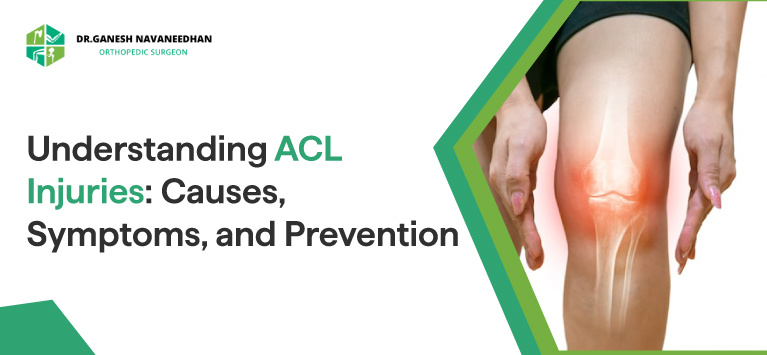- +91 62384 78716 +91 99475 78797
-
Sasthamangalam, Trivandrum
Sasthamangalam, Trivandrum

The cruciate ligaments are a paired anatomical structure (anterior and posterior) represented by dense tissue. They stabilize the knee joint, fix the lower leg, and prevent its displacement anteriorly and posteriorly. An anterior cruciate ligament tear is a frequent injury, but why does it happen? This article will examine the causes of ACL injuries and their diagnosis, treatment, and preventative techniques.
The anterior cruciate ligament (ACL) is a major ligament that maintains joint stability in the knee’s anteroposterior plane. Its purpose is to restrict the tibia’s mobility about the femur. It starts superiorly between the femoral condyles and ends inferiorly on the anterior section of the tibial plateau. His ailments are among the most prevalent knee ailments. Knee injuries are rising among teenagers, particularly those participating in competitive sports.
Three bones – the femur, tibia, and patella – constitute the knee. Ligaments connect bones, and the knee has four main ligaments:
The Injury occurs when the ligament twists or tears. There are three types or degrees of Injuries which depend on the severity.
The typical symptom of anterior cruciate ligament Injuries is the sensation of hearing the knee “crack.”
Other indications and symptoms may include:
Most injuries occur during sporting activities that put the knee to the test with movements such as rapid changes of direction, abrupt twisting movements on the lower limb, sudden slowdowns, jumps, and direct contact. Football, basketball, gymnastics, and skiing have the highest rate of cruciate ligament injuries. But even a fall from the bicycle could result in Injuries to the anterior cruciate ligament.
Other risk factors may be
During the specialist visit, the orthopedic surgeon examines the child’s knee by checking all its structures. A clinical examination may be sufficient for the diagnosis if anteroposterior instability is found with specific tests (Lachman test, anterior drawer test, jerk test).
In any case, the doctor may prescribe other tests, such as:
Diagnosis is radiographic, and the physician who evaluates and treats ligament injuries in childhood must be familiar with the types of injuries and complications typical of such patients.
In 90% of cases, they are accompanied by bone detachments, and only 10% are they pure ligament injuries. The occurrence of ligament Injuries accompanied by bone detachment is a real surgical emergency for the young patient.
When the anterior cruciate ligament is subjected to high stress, the intercondylar eminence, which has not yet fully ossified, provides less resistance than the ligament, resulting in a fracture of the cancellous bone below the intercondylar eminence of the tibia, unlike in adults.
Treatment depends on the type of fracture and fragment displacement and may range from casts or braces or require arthroscopically assisted surgical treatment. Parents must understand the severity of the Injuries and its possible sequelae.
To minimize discomfort and swelling, first aid care is vital. The most important things to perform immediately after a suspected knee injury are rest, ice, compression, and elevation (RICE self-care regimen). A damaged ligament cannot be repaired without surgery.
In senior people with restricted activity, nonsurgical therapy is favored. Bracing and physical therapy may be used in this scenario.
Surgery may be considered if:
The most frequent surgery for anterior cruciate ligament injuries is reconstruction. The orthopedic surgeon uses a tissue transplant to repair the injured ligament. It makes use of tendons extracted from another region of the knee (often the back of the leg). After surgery, fast and intensive rehabilitation is essential. It may take 5 to 8 weeks before an athlete can return to sport if muscle strength is fully restored.
A number of prevention programs have been developed to reduce non-contact ACL injuries. The main emphasis in these programs is on the correct control of the neuromuscular system of the knee. Programs focus on plyometrics, balance, and strength and stability exercises. Plyometrics are fast, powerful movements that first stretch the muscle (eccentric phase) and then contract it (concentric phase). This cycle of stretching and contraction increases muscle strength. Here is an example of this type of exercise: the athlete jumps down from a small rise and, as soon as he touches the floor, jumps into the air.
Workouts to develop a sense of balance usually include exercises on a balancing board (balance board). Outdoor balancing exercises may involve throwing the ball to a partner while standing on one leg. To develop the strength and stability of the body on one leg, athletes perform exercises such as jumping with a landing on one leg bent at the knee, holding this position after landing.
High-intensity plyometrics may be the key to preventing injuries of the ACL. Plyometric exercise should be done more than once a week for at least six weeks to achieve the optimum effects. Athletes are trained to land correctly: on the ball of the foot, with their knees bent and their chest over their knees.
In order to avoid bending the knees inward, the athlete must perform exercises under supervision and receive information about the correct position of the knees. In many of the latest programs, coaches have included in the warm-up, for example, jumping over a soccer ball and exercises to practice correct landing technique.
In conclusion, understanding ACL injuries is crucial for maintaining knee health. This article has provided valuable insights, from causes and symptoms to prevention strategies and treatment options. For personalized guidance, consult a reputable medical professional who can steer you toward the best choices for your health and recovery.
Copyright © 2025 Dr. Ganesh Navaneedhan. All Rights Reserved. | Designed By Harvee healthcare